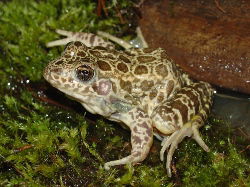 Madison, In. — Dr. Joe Robb, Refuge Manager at Big Oaks National Wildlife Refuge, will speak on Monday, March 4, at the monthly meeting of the Big Oaks Conservation Society. The meeting will begin at 6:30 p.m. at the Madison – Jefferson County Public Library in Madison, IN. Join us as Dr. Robb discusses “Management for the state endangered crawfish frog at Big Oaks National Wildlife Refuge”. The talk will detail the crawfish frog’s unique life history, refuge management, and their population status in the state and at Big Oaks. He will also compare different breeding calls of frogs and toads that will soon begin calling from their breeding wetlands. Dr. Robb received a Bachelor of Science in Forestry from Purdue University, and a Master of Science and a PhD from The Ohio State University in Wildlife Ecology. Dr. Robb is currently Project Leader of the Big Oaks and Muscatatuck National Wildlife Refuge Complex.
Madison, In. — Dr. Joe Robb, Refuge Manager at Big Oaks National Wildlife Refuge, will speak on Monday, March 4, at the monthly meeting of the Big Oaks Conservation Society. The meeting will begin at 6:30 p.m. at the Madison – Jefferson County Public Library in Madison, IN. Join us as Dr. Robb discusses “Management for the state endangered crawfish frog at Big Oaks National Wildlife Refuge”. The talk will detail the crawfish frog’s unique life history, refuge management, and their population status in the state and at Big Oaks. He will also compare different breeding calls of frogs and toads that will soon begin calling from their breeding wetlands. Dr. Robb received a Bachelor of Science in Forestry from Purdue University, and a Master of Science and a PhD from The Ohio State University in Wildlife Ecology. Dr. Robb is currently Project Leader of the Big Oaks and Muscatatuck National Wildlife Refuge Complex.
The Big Oaks Conservation Society is the non-profit support group of the Big Oaks NWR. Society members work closely with refuge staff to enhance public awareness, use, and appreciation for the natural and cultural assets unique to Big Oaks NWR. The Society currently maintains and manages Old Timbers Lodge, a beautiful historic structure nestled on a bluff overlooking Graham Creek on the northern portion of the property. Meetings are held the first Monday of each month at 6:30 p.m. usually at the Madison- Jefferson County Public Library in Madison, Indiana.
Big Oaks National Wildlife Refuge (NWR) consists of approximately 50,000 acres on the former Jefferson Proving Ground (JPG) located in Jennings, Ripley, and Jefferson Counties in southeastern Indiana. The refuge is managed by the U.S. Fish and Wildlife Service and provides public use opportunities such as hunting, fishing, wildlife observation and photography, interpretation and environmental education. The refuge has one of the largest contiguous forest blocks in the southeastern part of the state as well as one of the largest grassland complexes in the state, both of which provide wonderful wildlife viewing opportunities to refuge visitors.
The U.S. Fish and Wildlife Service is the principal federal agency responsible for conserving, protecting and enhancing fish, wildlife and plants and their habitats for the continuing benefit of the American people. The Service manages the 150-million-acre National Wildlife Refuge System, which encompasses more than 550 national wildlife refuges, thousands of small wetlands and other special management areas. It also operates 70 national fish hatcheries, 63 Fish and Wildlife Management offices and 81 ecological services field stations. The agency enforces federal wildlife laws, administers the Endangered Species Act, manages migratory bird populations, restores nationally significant fisheries, conserves and restores wildlife habitat such as wetlands, and helps foreign governments with their conservation efforts. It also oversees the Federal Assistance program, which distributes hundreds of millions of dollars in excise taxes on fishing and hunting equipment to state fish and wildlife agencies.



